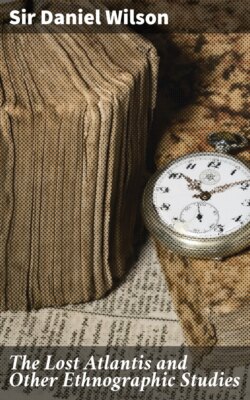The Lost Atlantis and Other Ethnographic Studies

Реклама. ООО «ЛитРес», ИНН: 7719571260.
Оглавление
Sir Daniel Wilson. The Lost Atlantis and Other Ethnographic Studies
The Lost Atlantis and Other Ethnographic Studies
Table of Contents
THE LOST ATLANTIS. I. EARLY IDEAS
II. THE VINLAND OF THE NORTHMEN
III. TRADE AND COMMERCE IN THE STONE AGE
IV. PRE-ARYAN AMERICAN MAN
V. THE ÆSTHETIC FACULTY IN ABORIGINAL RACES
VI. THE HURON-IROQUOIS: A TYPICAL RACE
Comparative Table of Numerals
VII. HYBRIDITY AND HEREDITY
VIII. RELATIVE RACIAL BRAIN-WEIGHT AND SIZE
TABLE I
TABLE II
TABLE III
TABLE IV
TABLE V
TABLE VI
TABLE VII
TABLE VIII
TABLE IX
TABLE X
INDEX
Отрывок из книги
Sir Daniel Wilson
Published by Good Press, 2019
.....
This land of the vine, discovered by ancient voyagers on the shores of the New World, naturally awakened the liveliest interest in the minds of American antiquaries and historical students; nor is that interest even now wholly a thing of the past. Is this “Vinland the Good” a reality? Can it be located on any definite site? Montgomery’s Greenland epic was published in 1819; and the poet, with no American or Canadian pride of locality to beguile him in his interpretation of the evidence, observes in one of the notes to his poem: “Leif and his party wintered there, and observed that on the shortest day the sun rose about eight o’clock, which may correspond with the forty-ninth degree of latitude, and denotes the situation of Newfoundland, or the River St. Lawrence.” The reference here is to the sole data on which all subsequent attempts to determine the geographical location of Vinland have been based; and after upwards of sixty years of speculation and conjecture, Professor Gustav Storm in his Studier over Vinlandsreiserne, arrives at a nearly similar conclusion. Vinland cannot have lain farther north than 49°. How far southward of this its site may be sought for is matter of conjecture; but all probabilities are opposed to its discovery so far south as Rhode Island.
Professor Rafn, however, arrived at very different results; and found abundant confirmation in the sympathetic responses of the Rhode Island antiquaries. The famous Dighton Rock was produced, with its assumed runic inscription. The Newport Round Tower was a still more satisfactory indication of permanent settlement by its supposed Norse builders; and “The Skeleton in Armour,” on which Longfellow founded his ballad romance, was accepted without hesitation as a glimpse of one of the actual colonists of Vinland in the eleventh century. Professor Rafn accordingly summed up the inquiry, and set forth the conclusions arrived at, in this definite fashion. “It is the total result of the nautical, geographical, and astronomical evidence in the original documents, which places the situations of the countries discovered beyond all doubt. The number of days’ sail between the several newly-found lands, the striking description of the coasts, especially the sand-banks of Nova Scotia; and the long beaches and downs of a peculiar appearance on Cape Cod (the Kialarnes and Furdustrandir of the Northmen,) are not to be mistaken. In addition hereto we have the astronomical remark that the shortest day in Vinland was nine hours long, which fixes the latitude of 41° 24′ 10″, or just that of the promontories which limit the entrance to Mount Hope Bay, where Leif’s booths were built, and in the district around which the old Northmen had their head establishment, which was named by them Hóp, or the Creek.”
.....